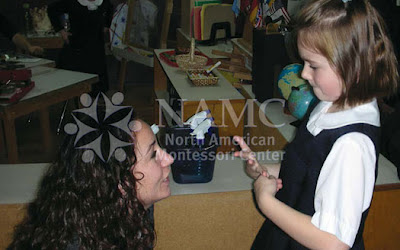
It is often said that they eyes are the window to the soul. Indeed, making or maintaining eye contact often communicates the real intent of our verbal message. In western societies, people who make eye contact come across as confident and honest. People take you more seriously and believe that what you are saying is important. Eye contact also provides an emotional connection between the speaker and the listener. Eye contact is an important non-verbal means of communication, and is a critical component for creating an ideal Montessori learning environment.
Montessori Values Explained: The Importance of Eye Contact in the Prepared Environment

We do the same thing when a child is speaking to us. If for example, a teacher is standing watering a plant and a child requires help, the Montessori teacher lowers herself to the child’s level in order to fully attend and engage in what is being said. This courtesy extends to the child that what they are saying is important to the teacher.
When inviting a child to participate in an activity or lesson, the Montessori teacher makes deliberate eye contact with the student, smiles, and then begins the demonstration. By making eye contact before beginning a Montessori lesson, you are signaling to the student that they need to give their attention to the lesson and they in return are telling you they are ready to learn.
Humans communicate thoughts, feelings, ideas, and emotions through our use of language. We generate and share new ideas and tell stories of our past through the spoken and written word. But language is not limited to words; it includes the messages we send with our bodies.
As Montessori parents and educators, let us remember to engage our children and students by being truly present whenever we communicate with them. The eyes have it – they can clearly express our interest in, respect for, and connection to the child.
Related NAMC Blogs:
- Montessori Values Explained: The Importance of Tone and Voice Level in the Prepared Environment
- Montessori Values Explained: The Importance of Precise Language in the Prepared Environment
As much as possible, NAMC’s web blog reflects the Montessori curriculum as provided in its teacher training programs. We realize and respect that Montessori schools are unique and may vary their schedules and offerings in accordance with the needs of their individual communities. We hope that our readers will find our articles useful and inspiring as a contribution to the global Montessori community.
© North American Montessori Center - originally posted in its entirety at Montessori Teacher Training on Thursday, February 11, 2010.
© North American Montessori Center - originally posted in its entirety at Montessori Teacher Training on Thursday, February 11, 2010.

0 comments:
Post a Comment
Have questions or comments? Let us know what you thought about this article!
We appreciate feedback and love to discuss with our readers further.